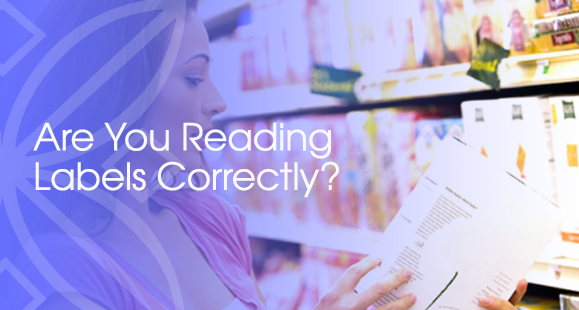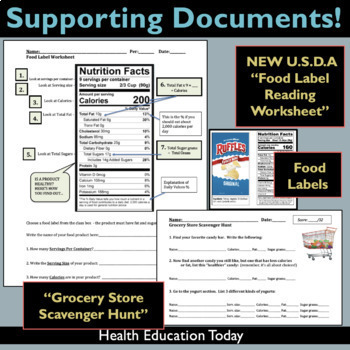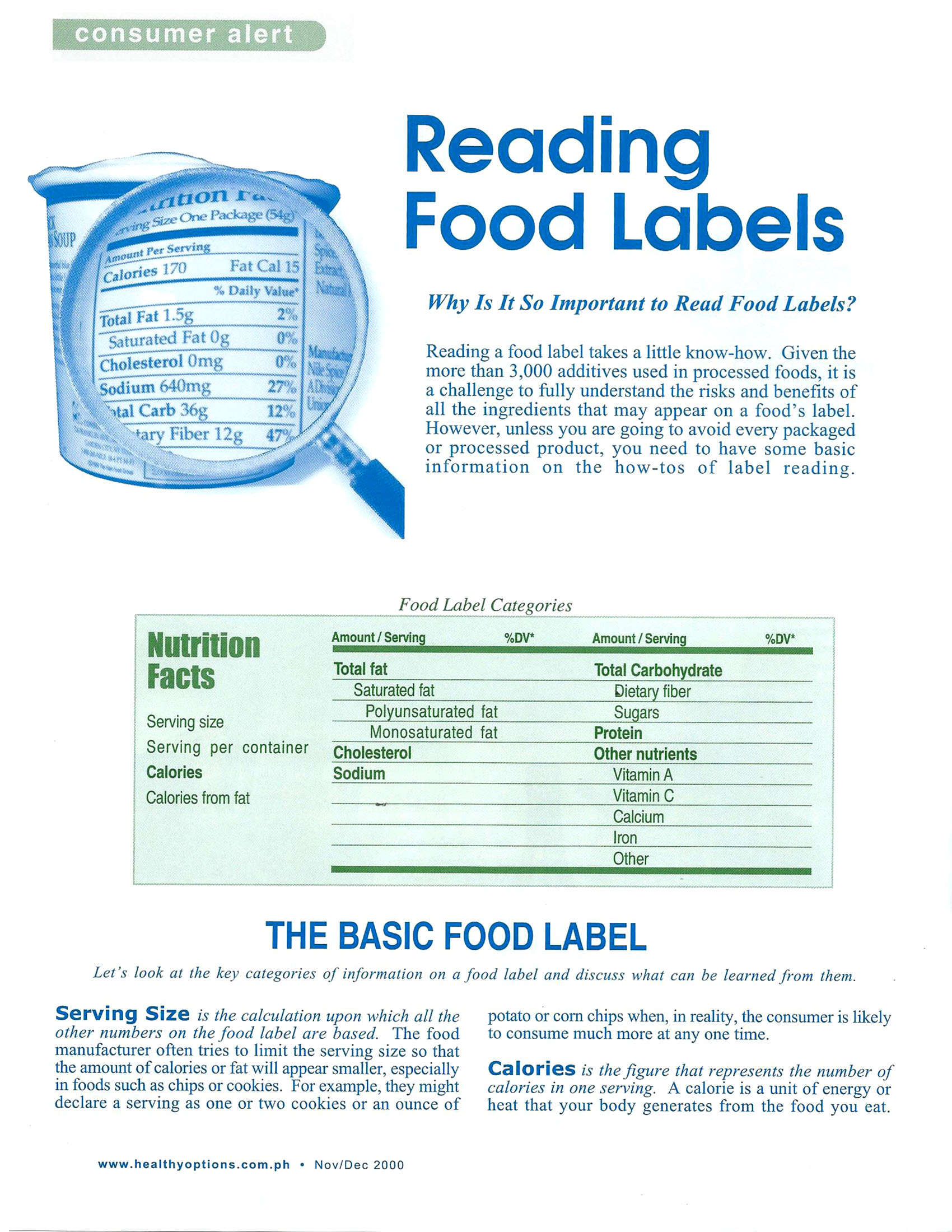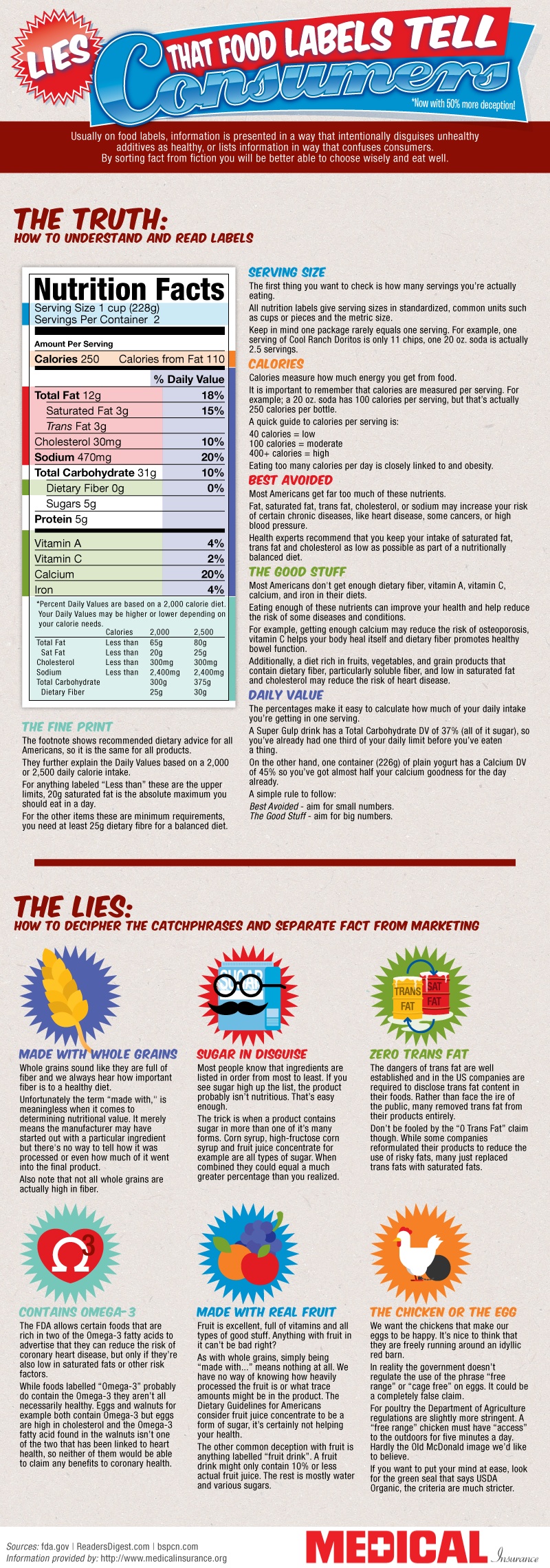44 reading and understanding food labels
Why it is important to read and understand food labels ... The food label will provide information on what you are putting into your body by reading the ingredients and how much you are eating by reading the nutrition facts. For most people with diabetes it is ideal to maintain a healthy weight. In order to do this, we must understand what nutrients we are putting in our meals. How to Understand and Use the Nutrition Facts Label | FDA The information in the main or top section (see #1-4) of the sample nutrition label (below) can vary with each food and beverage product; it contains product-specific information (serving size, calories, and nutrient information). The bottom section contains a footnote that explains the % Daily Value and gives the number of calories used for genera...
how to understand food labels - Eat For Health how to understand food labels What to look for… Don’t rely on health claims on labels as your guide. Instead learn a few simple label reading tips to choose healthy foods and drinks, for yourself. You can also use the label to help you lose weight by limiting foods that are high in energy per serve. 100g Column and Serving Size

Reading and understanding food labels
Understanding Ingredients on Food Labels | American Heart ... 6.3.2017 · Food labels are an important source of information about calories and the nutritional value of the foods you eat, ... Kris-Etherton said there’s no reason to complicate your label reading to this degree. ... Understanding Food Nutrition Labels Understanding Ingredients on Food Labels ... Understanding Food Labels in Canada - Unlock Food How to use the Nutrition Facts table Step 1: Look at the serving size The serving size is at the top of the Nutrition Facts table. All the information in the Nutrition Facts table is based on this amount. Compare this to the amount of food you actually eat. Understanding Food Labels - Nutrition: Science and ... The FDA uses the following definitions for interpreting the %DV on food labels:4 5%DV or less means the food is low in a nutrient. 10% to 19%DV means the food is a "good source" of a nutrient. 20%DV or greater means the food is high in a nutrient.
Reading and understanding food labels. Reading and understanding food labels - Human Kinetics Food labels are not required on fresh meat, poultry, raw seafood, fresh fruit and vegetables, food prepared or processed in store, foods that contain very few nutrients (e.g., vinegar, spices), and alcoholic beverages, although you can find nutrient information for these foods on Health Canada's website. Understanding Pet Food Labels - How To Read And What ... Therefore, pet food labels usually follow the same format: Product and brand name Quantity of product weight, liquid measure, or count Analysis that is supported by a respected body Listed nutrients Ingredients listed in order by weight Nutritional adequacy statement Feeding guidelines Calories statement Manufacturer's information Food label reading and understanding in parts of rural and ... Food label reading and understanding in parts of rural and urban Zimbabwe Abstract Background: Overweight and obesity prevalence is rapidly rising in developing countries. The reading and understanding of nutrition information on food packages has been shown to improve food choices and instill healthy eating habits in individuals. PDF Reading and Understanding Food Date Labels Use your senses. The best way to determine if food is safe to eat is by taste and smell. If it smells off, tastes strange or has an unusual texture, it's probably best to avoid it. To learn more visit: Save the Food USDA Food Product Dating How dated food labels contribute to food waste NPR.org FOOD DATE LABELS READING AND UNDERSTANDING
Food Labels | CDC Apr 23, 2021 · If you eat the whole thing, you are eating 8 times the amount of calories, carbs, fat, etc., shown on the label. Total Carbohydrate shows you types of carbs in the food, including sugar and fiber. Choose foods with more fiber, vitamins, and minerals. Choose foods with lower calories, saturated fat, sodium, and added sugars. Avoid trans fat. 10 tips for understanding food labels - Heart Matters magazine 1. Read the ingredients list · 2. Check out the nutrition information · 3. You don't need to calorie count · 4. Look at the type of fat, and how much · 5. Beware of ... PDF Healthy Eating Workshop Reading and understanding food labels Reading and understanding food labels Workshop outline (60 minutes) 1. Welcome (5 minutes) 2. Whole versus processed foods ( 10 minutes) 3. Packaged Foods - how do you choose? (30 minutes) 4. Let's Practice (10 minutes) 5. Closing (5 minutes) Suggested handout: How to Read a Nutrition Facts label (see Page 2 of the above linked handout) Understanding Food Nutrition Labels | American Heart ... Mar 06, 2017 · Learn what to look for on the label. 1 - Start with the serving information at the top. This will tell you the size of a single serving and the total number of servings per container (package). 2 - Next, check total calories per serving and container.
Food labels - NHS Nutrition labels are often displayed as a panel or grid on the back or side of packaging. This type of label includes information on energy (kJ/kcal), fat, ... Understanding Food Labels | The Nutrition Source | Harvard ... Understanding Food Labels The information on food labels is intended to help consumers become savvy about their food choices. The front, back, and sides of a package are filled with information to inform us what the food contains and to provide guidance in making healthier selections of processed foods. PDF Healthy Eating Workshop Food Labels - Welcome to NYC.gov After today's workshop, you will: 1. Know where to find reliable information on food packaging 2. Understand how to verify information on the front of food labels 3. Be able to use information on food packaging to make healthy and informedfood choices Whole Foods Nothing added, nothing taken away No unhealthy fat sugar or salt added No vitamins Reading Food Labels | ADA - American Diabetes Association Reading Food Labels | ADA Understanding Food Labels It's time to decode those food claims. Trying to figure out nutritional information on labels and packaging isn't easy. The good news is that we can help. Untangle packaging claims. If you get tripped up on food content claims, you're not alone. Fat free vs. low fat vs. reduced fat.
Environmental Print | Reading Rockets It's the name given to the print that appears in signs, labels, and logos. Street signs, candy wrappers, labels on peanut butter and the K in Kmart are other examples of environmental print. For many emergent readers, environmental print helps bridge the connection between letters and first efforts to read.
How to understand food labels - Eat For Health The Nutrition Information Panel on a food label offers the simplest and easiest way to choose foods with less saturated fat, salt (sodium), added sugars and kilojoules, and more fibre. It can also be used to decide how large one serve of a food group choice or discretionary food would be and whether it's worth the kilojoules.
How to Read Food Labels | Mark's Daily Apple Grocery shopping can be a tad overwhelming, especially when you’re trying a new way of eating. Primal, paleo, keto, Whole30, vegetarian, vegan—they all have their own set of guidelines about what foods are “allowed” and which you should limit or avoid.
Understanding food labels fact sheet - NDSS Understanding how to read food labels can help you choose foods with more fibre and less saturated fat, salt (sodium), added sugars and kilojoules. Food labels will typically include a nutrition information panel, list of ingredients, the 'use by' or 'best before' date and identify potential food allergens and additives.
How to read food labels - healthdirect Home / Top Tips for Low Gi Living / Reading Food Labels Reading Food Labels To help work out the amount of carbohydrates (or number of exchanges) in a food and make low Gi choices, a basic understanding of food labels is important. Read more on Glycemic Index Foundation website.
Understanding food labels - Canada.ca Understanding food labels. Food labels, nutrition facts tables, serving size, ingredients, % daily value, nutrition claims. Services and information. Nutrition facts tables. How to use, what is in them, foods that don't have a nutrition facts table. Serving size.
Understanding food labels - Diabetes UK The labels show how many calories are in the food or drink and are also colour coded to show whether the food is low (green), medium (amber) or high (red) in fat, saturated fat, sugar and salt. The information on the front of the pack also tells you how the portion of the food contributes to the Reference Intake (RI) of an adult.
Food Labels 101: Understanding the Nutrition Facts Label ... Nutrition labels can be a great tool for managing a heart healthy diet, which makes it very important that you understand what you're looking at when you read a label. Nutrition labels are based on a daily 2,000 calorie diet. Depending on your age, gender and activity level, you may need to consume more or less than 2,000 calories per day, so ...
Reading and understanding food labels - Human Kinetics Canada Food labels are not required on fresh meat, poultry, raw seafood, fresh fruit and vegetables, food prepared or processed in store, foods that contain very few nutrients (e.g., vinegar, spices), and alcoholic beverages, although you can find nutrient information for these foods on Health Canada's website.
Using the Nutrition Facts Label - Food and Drug Administration Understanding what the Nutrition . Facts Label includes can help you . make food choices that are best for your health. 1. 2. 4. 3. 5. 1. Serving Size. …
PDF A Guide to Reading Food Labels - University of Rochester Understanding the Percent Daily Values (% DV) on a food label can help you choose foods high in good nutrients and low in bad nutrients. The % DV is based on a 2,000-calorie diet. If you eat less than 2,000 calories a day, your daily value may be lower than what is listed on the label. If you eat more than 2,000 calories a day, your daily value
Food label reading: Read before you eat - PMC Sir, Nutrition information on food labels is regarded as a major means for encouraging consumers to make healthier choices when shopping for food.[1,2] However, do consumers notice such labels, do they read and understand them, and do they make use of them in their purchasing decisions?A range of consumer research studies[3,4,5] have tried to shed light on these questions.
Understanding Food Labels PDF | Food Allergy Reading every food label, every time is one of the best ways to keep you or your loved one safe. Many people who are managing food allergies use the "Rule of 3" for reading ingredient labels— read the label at the store, when unloading your groceries, and before serving the food—to triple-check that a food is safe.
The importance of reading and understanding food labels The Food Label is designed to help people choose foods well. By knowing how to use it, you can understand how a specific food item can fit into your overall diet. You can more effectively and efficiently select foods and choose between products. So go ahead, check the label and better manage your health. Stay happy, Stay healthy.
Reading & Understanding Food Labels - A Nutrition ... Reading & Understanding Food Labels - A Nutrition Discussion with Julia Ridenour, RD. Learning how to read and understand food labels can be a daunting task but it can help you make healthier choices. Here are some tips offered by Julia Ridenour, ...
Learning To Read Labels :: Diabetes Education Online On a nutrition food label, subtract the fiber from the total carbohydrate amount. When you read food labels, the grams of sugar are already included in the total carbohydrate amount, so you do not need to count this sugar amount separately. The grams of sugar listed include both natural sugars, from fruit or milk, and added sugars.









Post a Comment for "44 reading and understanding food labels"